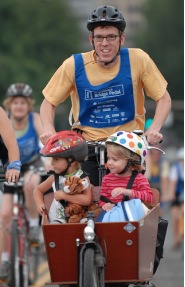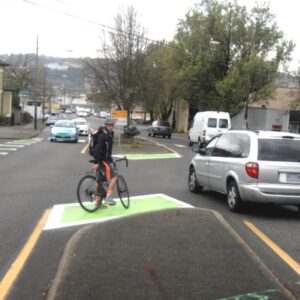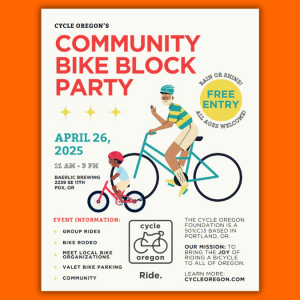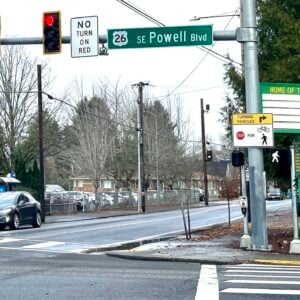
this one at Broadway and Williams, in 2012.
(Photos © J. Maus/BikePortland)
Starting January 1st, cities throughout Oregon will get the green light on bicycle signals.
Bike-specific signals aren’t new in Portland, the City’s Bureau of Transportation has used them for years now; but technically they’ve been doing so on an experimental basis. This past legislative session, the City helped pass Senate Bill 130, which codifies bicycle signals into Oregon law and makes them official traffic control devices with as much legal weight and respect as standard signals.
To learn more about bike signals and the new law, we asked PBOT’s Signals and Street Lighting Division Manager, Peter Koonce (in photo at right) a few questions. Koonce rides a bike around town often and he brings that sensibility to his work. Last February, Koonce testified on behalf of SB 130, telling legislators that they should pass the bill because,
“Providing an exclusive signal display recognizes the differences between motor vehicles, bicycles and pedestrians, and it separates bicycles from conflicting movements.”
Koonce answered a few of our questions below…

in good hands!).
“The law adds the green, yellow and red bicycle symbols displayed in bike signals to list of traffic control devices. Additionally, flashing yellow arrow symbols are defined in the law. These definitions were not in the Oregon Vehicle Code or the Uniform Vehicle Code, which most states use as the base from which to build their own state Vehicle Code. It allows Police to enforce violations of the displays at intersections as we do other traffic control devices.”
“The City of Portland installed its first bicycle signal in 2004 at N Interstate and N Oregon. The bicycle signal has improved compliance, is intuitive and has been an effective tool to communicate expectations to users at the intersection. Perhaps the most important element of bike signals’ introduction is the improved safety performance. For example, we haven’t experienced any bicycle-related crashes at the intersection in the seven years since the signal began operating.”
“The City has worked closely with the Federal Highway Administration to develop experimental designs that allow us to test new traffic control devices such as the bike signal at N Interstate. The bicycle box study is another example of the City doing experimental traffic engineering to test yet-to-be-approved traffic control that looks promising. More information on the Federal process is available on their website.”
“There are several locations where bicycle signal displays would reduce potential conflicts and remove unnecessary delay. We look forward to working get them installed under the new law.
For example, we are currently designing a bicycle signal for the westbound movement at the intersection of NE Martin Luther King Jr. Blvd. and NE Lloyd Blvd.
The Portland to Milwaukie Light Rail project is a large project for the region and we are incorporating bicycle signals to control some of the unique movements that will result to insure safe operations of people on bicycles, buses and light rail trains.
The new law clarifies the meaning of the signal display and allows enforcement with less ambiguity.”
“There has been considerable interest nationally in our efforts. Denver recently implemented their first bicycle signal, Eugene turned on their first bicycle signal in December of this year, and Clackamas County, Ashland and Salem have designed bicycle signals for their localities.”
—
In some ways, this official recognition of bike-only signals is yet another way that Portland is moving toward more separation between transportation modes. Keep your eyes peeled for bike signals in 2012.







Thanks for reading.
BikePortland has served this community with independent community journalism since 2005. We rely on subscriptions from readers like you to survive. Your financial support is vital in keeping this valuable resource alive and well.
Please subscribe today to strengthen and expand our work.
I use the one at Sandy and 57th every day. It gets some puzzled looks from some of the drivers, but it’s mostly pretty clear what’s going on and compliance is great.
I think part of the reason is that the bike green signal is sequenced so that cars on Sandy are already stopped when it comes up, so I’ve rarely seen cars trying to beat a yellow/red and running through.
Always a delight to use the E Burnside/41st bike signal — fast responding, & seems to get good compliance (& a lot of use by cyclists!)
What ever became of the Clackamas Co. bike signal project at Bell/Johnson Creek Blvd/Springwater trail crossing you reported on in May? I was supposed going in this Fall, but I went through there a few weeks back and no sign of anything happening…?
Hope this hasn’t been derailed, it is indeed a prime “bad mojo” cycling location. Awkward, slow, dangerous, & generally frustrating on a bike.
The Johnson Creek Blvd/Bell Ave should have the new bike signals on a dedicated phase. The project is just behind schedule.
thanks, Vinny – i was a little worried the budget-cutting goblin had eaten it.
I believe this location is not within Portland’s city limits – therefore, not as quick to fix the problem.
This has spurred an interesting side thread on Google+. Feel free to chime in.
Good news!
Though I would recommend that all jurisdictions utilizing bike signal head on far side installations add a supplemental smaller bike signal near side, especially if the intersection is large (suburban) or has a complex cycle (split movements, esp. for bikes.) This practice works well in other countries with very developed bike infrastructure and much lower traffic crash rates.
During my recent trip to Vancouver BC, I got to utilize their bike track with it’s bike signalization – they got 90% of it right, but the absence of near side bike signal head and poor signal head placement made me make several [novice] errors on which movement priority I had – I went straight when I, as a cyclist, should not have – the right [hook] turning traffic had the right of way. (Gladly I survived w/o injury to myself or others.)
I just wrote about this today on Grid Chicago. In Copenhagen, there’s a near side bike signal, and a far side bike signal.
http://gridchicago.com/2011/safer-roadway-designs-how-danes-make-right-turns/
Todd-
PBOT just procured the first nearside signal in the U.S. and placed it at SW Moody & Gibbs at the south end of the new cycletrack. Dave over at Portlandize.com mentioned it in his blog post. http://portlandize.com/2011/11/cycle-track-after-a-couple-of-weeks/
The nearside signals are to further clarify intent at the intersections.
http://koonceportland.blogspot.com/2011/11/sw-moody-nearside-bike-signal.html
Thanks Peter for the good news – I will have to go and check it out. (Happy New Year!) T
i come up on the 41st and burnside light. i was wondering, if the traffic is clear do i still have to press the button and wait for my green?
Yes. Normal signal rules apply.
Since it’s stop-controlled (on 41st), my assumption has been that a bicyclist can proceed after stopping (like a motorist does) without using the signal button -the same as at pedestrian signals (e.g., SE Taylor and 39th) whether they have a curbside button provided for cyclists to activate the signal, or not.